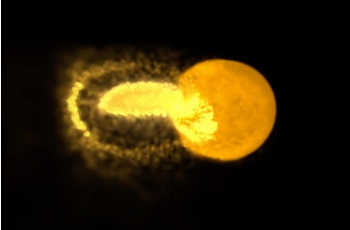The moon is far more than a largely dead orb. Our planet’s pale satellite is the creator of tides, the catcher of meteors and the only other world in the starry ocean where humanity has set foot. But scientists are still not entirely clear how it was made. Solving this mystery would not only reveal the moon’s origins, it would also help explain our own planet’s evolution.
A study suggests that the moon was forged from the fires of an ocean of magma sloshing over baby Earth’s surface. If correct, this model may solve a longstanding paradox.
Lunar meteorites and samples collected during the Apollo missions show that the moon and Earth have remarkably similar geochemical fingerprints. Scientists suspect that this was likely the result of a giant impactor the size of Mars, known as Theia, that slammed into a young Earth and sent into orbit a spiral of material that coalesced into the moon.
Countless computer simulations show that this is possible, but there’s a problem. Such an impact on a relatively solid Earth would have created a moon made mostly out of Theia, not Earth (at least in simulations resulting in the Earth-moon system we observe today, complete with our 24-hour days).
The new research, adds what may be the recipe’s missing ingredient. During Earth’s earliest days, it was covered by a sheet of molten silicate rock. The team wondered what would have happened if Theia had crashed into Earth at that time, rather than during a later, cooler, more solid phase.
The team used a standard moon-forming simulation but adjusted it to better replicate density changes throughout the objects. With these tweaks, they found that the magma ocean made all the difference.
Immediately after Theia’s impact, Earth’s hot, squishy layer would have violently cascaded into space in huge volumes. This material orbited and coalesced around the young Earth, forming a moon made of about 70 percent terrestrial material, far more than in older, largely solid Earth models, which came out at around 40 percent.
The astrophysicists said that this magma-ocean model moves us some way toward explaining the geochemical mirroring of both objects, while also reproducing the way in which Earth and the moon dance around each other. “It’s a very exciting result,” they said. However, it is very different from earlier work, so the key to this model’s validity is to see if future models can replicate it.
Part of the problem is that scientists don’t have sufficient samples from which to obtain model data. Although the Apollo rocks are an important scientific resource, they came only from a small patch near the moon’s Equator. “Imagine if we tried to reconstruct the entire history of the Earth using a tiny handful of samples,” they said. “We couldn’t do it.”
We need to return to the moon, dig deep and bring home as many lunar fragments as possible.
Lara Khouli


 Home
Home